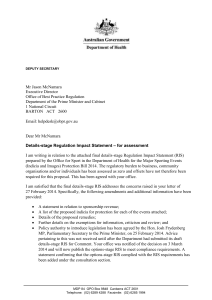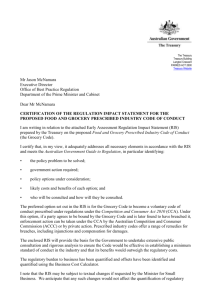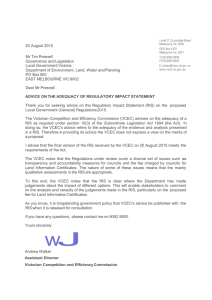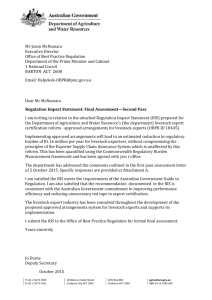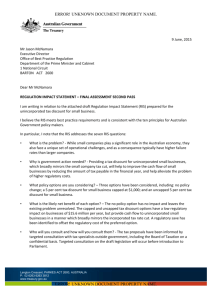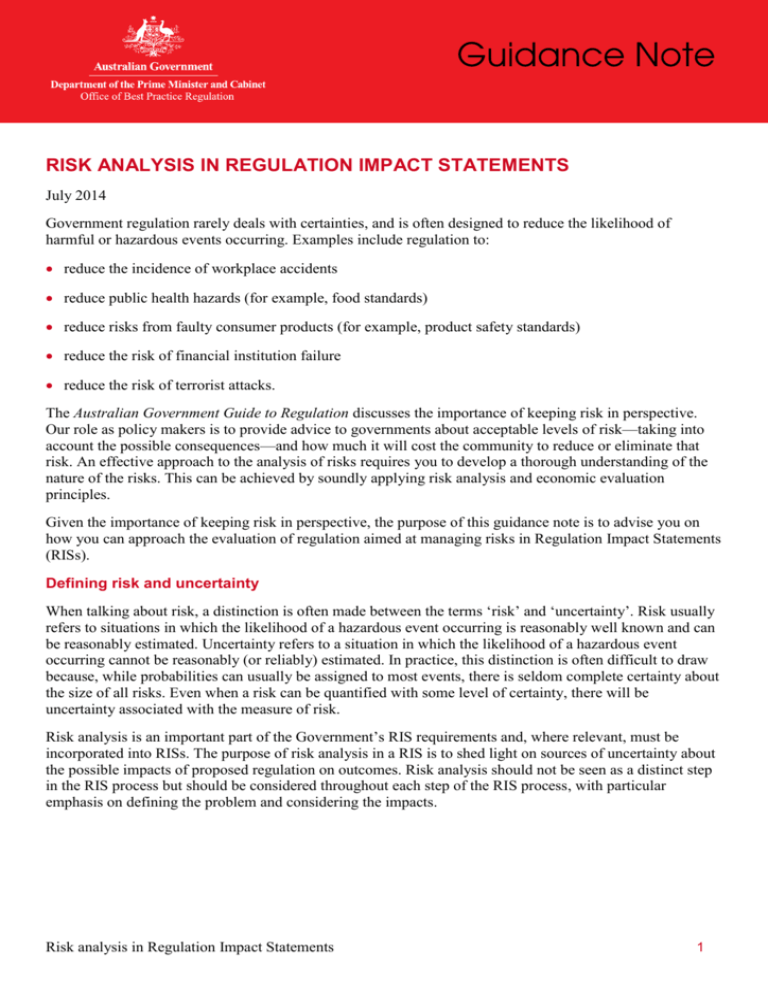
RISK ANALYSIS IN REGULATION IMPACT STATEMENTS
July 2014
Government regulation rarely deals with certainties, and is often designed to reduce the likelihood of
harmful or hazardous events occurring. Examples include regulation to:
reduce the incidence of workplace accidents
reduce public health hazards (for example, food standards)
reduce risks from faulty consumer products (for example, product safety standards)
reduce the risk of financial institution failure
reduce the risk of terrorist attacks.
The Australian Government Guide to Regulation discusses the importance of keeping risk in perspective.
Our role as policy makers is to provide advice to governments about acceptable levels of risk—taking into
account the possible consequences—and how much it will cost the community to reduce or eliminate that
risk. An effective approach to the analysis of risks requires you to develop a thorough understanding of the
nature of the risks. This can be achieved by soundly applying risk analysis and economic evaluation
principles.
Given the importance of keeping risk in perspective, the purpose of this guidance note is to advise you on
how you can approach the evaluation of regulation aimed at managing risks in Regulation Impact Statements
(RISs).
Defining risk and uncertainty
When talking about risk, a distinction is often made between the terms ‘risk’ and ‘uncertainty’. Risk usually
refers to situations in which the likelihood of a hazardous event occurring is reasonably well known and can
be reasonably estimated. Uncertainty refers to a situation in which the likelihood of a hazardous event
occurring cannot be reasonably (or reliably) estimated. In practice, this distinction is often difficult to draw
because, while probabilities can usually be assigned to most events, there is seldom complete certainty about
the size of all risks. Even when a risk can be quantified with some level of certainty, there will be
uncertainty associated with the measure of risk.
Risk analysis is an important part of the Government’s RIS requirements and, where relevant, must be
incorporated into RISs. The purpose of risk analysis in a RIS is to shed light on sources of uncertainty about
the possible impacts of proposed regulation on outcomes. Risk analysis should not be seen as a distinct step
in the RIS process but should be considered throughout each step of the RIS process, with particular
emphasis on defining the problem and considering the impacts.
Risk analysis in Regulation Impact Statements
1
What is the policy problem you are trying to solve?
As discussed in the Australian Government Guide to Regulation, RIS question 1 should clearly define the
problem you are trying to solve and demonstrate why it is a problem. In the case of regulation aiming to
mitigate risks or reduce harms, the problem definition should identify the underlying cause of the problem,
its seriousness and your capacity to deal with it. The RIS should clearly identify whether there is a case for
government intervention. This means that the RIS should contain relevant information on the likelihood of
the risk as well as the consequences of the risk (discussed below). The problem section should also clearly
identify who bears the risk and highlight how the risk is currently being dealt with.
Actual versus subjective risks
The RIS should focus on objective risks rather than ‘perceived’ risks. Perceptions about risk can be founded
on bias and misinformation about the true magnitude and severity of risks (Viscusi et al. 1995). Individuals
can often perceive a risk (or harm) to be much greater than it actually is—especially when there is a lack of
information about the risk or strong perceptions about the size of the risk. To avoid this error, you should
focus on evidence about actual risks and seek to quantify the actual risk.
Perceptions about risk, however, should not be entirely overlooked. If there is inadequate information about
a risk, or public misperception about a risk, that may call for government action to reduce the degree of
misperception about the risk. For example, there is often considerable public misperception about many
health risks (such as the risks of sun exposure and risks associated with binge drinking). A possible response
would be to inform the public through appropriate campaigns aimed at reducing the extent of
misinformation.
Likelihood versus consequences
The size of a risk is usually characterised by the likelihood of an event occurring (that is, the probability of
the adverse event or harm occurring), and the consequences should the event occur.
Measuring risk can be a difficult task but can be achieved using reliable sources of information. Quantifying
the magnitude of the risk is an important first step because it will inform the assessment of the likely net
benefit of each regulatory option (and cost–benefit analysis) at a later stage of the RIS process. Sources of
information to identify the likelihood and consequences of risks include:
accident and incident data (such as fatality rates and incidence statistics)
coroners’ reports
actuarial estimates
medical research data (such as medical studies and epidemiological studies)
expert panel surveys
targeted surveys.
You can use information from these sources to inform stakeholders and decision makers about all the
relevant facts so that they can make an informed decision. When using data from secondary sources as
evidence, it is important to ensure that the estimates used appropriately characterise the risk associated with
the problem being considered.
Risk analysis in Regulation Impact Statements
2
Where perceived risks are deemed important, the RIS should also inform stakeholders about general risk
perceptions.
Some risks, however, will be very difficult to quantify; in these cases, sound qualitative assessments can be
used to supplement quantitative analysis. Discuss the size of the risk by reference to the likelihood of the
event occurring and the consequences of the occurrence. This assessment may be supported by a discussion
of the factors that contribute to the likelihood of the risk and by reference to the impacts of similar events
occurring in Australia or overseas.
The nature of the risk
The RIS should describe the nature of the risk and the adverse outcomes that could eventuate in the absence
of government action. Is it a risk that is straightforward to estimate (actuarial-type risks) or is the risk
characterised by random events (such as flood, earthquake or terrorist attack)?
The evaluation and analysis should consider whether there is a long delay between an adverse event and the
consequences (latent risks). The adverse consequences associated with climate change, for example, will
occur gradually over time. This means that the impacts of the associated consequences of climate change
will most likely happen slowly over time. Some risks, such as the risk of terrorism, tornados, floods and
some disease outbreaks, are characterised by random events that occur instantaneously and may require a
rapid response to deal with the impacts. However, other risks can be easily characterised because their
occurrence is more easily observable (such as risk of damage to property, risks due to fires, risk of death due
to car accidents).
Who bears the risk?
The RIS should discuss which groups will bear the consequences if an adverse event occurs (that is, the
parties affected). The distribution of the risk may have important consequences for efficiency (some parties
may be able to bear the risk at lower cost than other parties) and equity (it may be more socially acceptable
for some parties to bear risk than others). The RIS should outline whether the distribution of risk is an
important consideration.
What is the likely net benefit of each option?
As discussed in the Guide to Regulation, RIS question 4 should clearly assess the likely net benefit of each
regulatory option. This section of the RIS should give the decision maker a fair and balanced assessment of
the costs and benefits of each option. This means that you should assess the economic, social and
environmental costs and benefits as well as how those costs and benefits are likely to be distributed.
Assess the impact of the proposal on risk
You need to appropriately examine the impact of each option identified to manage the risk. Your impact
analysis should clearly spell out how each option will affect the size and distribution of the risk. For each
option being considered, this involves answering the following questions:
Will the option reduce the size of the risk (for example, using standards or providing information)?
Will the option remove the risk altogether (such as by banning certain activities or products)?
Will the option transfer risk from one party to another (for example, through mandatory insurance)?
Risk analysis in Regulation Impact Statements
3
A proposal may aim to reduce risks by imposing specific standards, such as food standards or product
quality standards, to improve product quality. In some instances, the proposal might aim to mitigate risk by
directly banning activities, such as cigarette smoking in vehicles or certain public spaces. Actions can also
be proposed to transfer or redistribute risks (for example, bank deposit guarantee schemes). You should
analyse each option clearly in the light of its impact on risk reduction, transfer or elimination, and in terms
of its impacts on all those affected (consumers, producers, governments and regulators).
Quantify the risk
Quantify the risks as far as possible.1 The RIS should consider whether the reduction in risk resulting from
the proposed regulation has an economic benefit that will be felt in the community. This means that the RIS
should contain your detailed assessment of the size of the actual risk. The analysis should be based on
existing sources of relevant evidence about risks or based on specific studies to uncover the size and
magnitude of the risk. The analysis in this section of the RIS will flow directly from the analysis given in the
problem section of the RIS. To apply cost–benefit analysis (CBA), you will need to be informed about:
the likelihood of the risk (an estimate of the actual risk)
the impact of the proposed regulation on probable future risk.
The latter will require that you make forecasts about how the proposed regulation or option will affect the
future size and magnitude of the risk.
How are risks and hazards measured in practice?
Risks and hazards are often measured by the ‘rate’ or ‘average number of occurrences’ for an event of
interest per 100,000 persons per period of time. For example, the expected annual number of cases of
salmonellosis from seed sprout consumption in Australia was estimated at 924.2 persons per year (Table 1).
Take care to ensure that all estimates used are reasonable estimates of the probability of the actual hazards
that you are evaluating. Consult data from different sources to compare and contrast estimates if such data is
available.
Decision makers can use evidence on risks and hazards to assist them to prioritise their responses.
Understanding the level of risk is important for the impact assessment. For meaningful impact analysis, it is
important to understand and form expectations about how each option will reduce risks into the future.
1
Any administrative, substantive compliance and delay costs must be quantified. For further information on these requirements, see the Regulatory Burden
Measurement framework guidance note at http://www.dpmc.gov.au/deregulation/obpr/reportingpublications/publications/guidance/docs/005_Regulatory_Burden_Measurement_Framework.pdf. All other costs must be quantified where possible.
Risk analysis in Regulation Impact Statements
4
Table 1: Expected annual cases of salmonellosis from seed sprout consumption in Australia
Annual cases of
salmonellosis in
Australia
Expected % of
annual
salmonellosis
cases associated
with seed sprout
consumption
Potential number
of cases in the
year
Probability of
observing
corresponding
number of cases
in that year (pj)
Expected
number of
cases
A
B
C = (A×B)
D
E = (C × D)
84,056
0.75%
(n0) 630.4
1.0
630.4
84,056
0.33%
(n1) 277.4
0.25
69.3
84,056
1.67%
(n2) 1,403.7
0.1
140.4
84,056
5%
(n3) 4,202.8
0.02
84.1
(nj)
Total (N)
924.2
Note: The number 84,056 is based on the number of attributed cases for 2010 (12,008) in the NNDSS 2010 summary on the
Department of Health website (http://www.health.gov.au/internet/main/publishing.nsf/Content/nndss-fortnightly-summary-notes2010) multiplied by 7 as per the recommendation of Hall et al. (2006) to take into account the level of underreporting.
Source: Proposal P1004—Primary Production and Processing Standard for Seed Sprouts Regulation Impact Statement, Food
Standards Australia New Zealand.
What if risks cannot be quantified?
When sound quantitative evidence is not available, qualitative discussion based on sound qualitative
evidence can also be used to inform the RIS. However, you should attempt to quantify all risks as far as
possible, noting that regulatory costs must be quantified in line with the Regulatory Burden Measurement
framework. When risks cannot be quantified, various approaches can be used to analyse their potential size
and impact. Qualitative tools for risk analysis include:
using opinions based on expert panels
using a risk categorisation matrix (prioritising or categorising according to informed judgements about
likelihood and severity)
comparative analysis (for example, comparing the effectiveness of risk management approaches across
different jurisdictions).
Assess the impact of each option by applying cost–benefit analysis
Decisions about risk management strategies should be informed by consideration of the costs and benefits of
regulation. Risk management strategies will impose costs and benefits on members of society and hence will
support different efficiency and distributional outcomes. In practical CBA, your aim is to quantify who will
be affected by the regulation and by how much. The key objective is to assess alternative risk management
options in terms of their relative efficiency outcomes. This means quantifying all costs and benefits
associated with a risk management strategy. You should also consider distributional impacts.
Risk analysis in Regulation Impact Statements
5
Consider potential unintended consequences of each option
Risk management policies can sometimes elicit adverse changes in the behaviour of economic agents
(consumers, suppliers and other actors in the economy). In particular, agents may engage in riskier
behaviour if they face a reduced likelihood of adverse consequences of that behaviour or if the consequences
are borne by another party. This is known as the moral hazard problem.
For example, proposals aimed at guaranteeing bank deposits may elicit excessive risk-taking behaviour by
financial institutions, which increases the probability of financial loss (Davis 2004).
Similarly, care should be taken in designing regulatory penalty regimes. The effectiveness of regulatory
penalties will depend not just on the quantum of the penalty, but also on the extent to which individuals
perceive that they are at risk of detection and enforcement action. The deterrence value of the penalty, in
turn, can be influenced by relevant social norms; the timeliness and salience of sanctions; and the extent to
which individuals or businesses can understand the law. The effectiveness of a given penalty may vary from
one person to the next.
When evaluating the impact of government intervention, it is important to consider the potential undesirable
consequences on the behaviour of all stakeholders affected. This can be taken into account by applying
sensitivity analysis within the CBA framework.
Dealing with uncertainty in risk analysis
Many risks are uncertain, which means that their size can be difficult to quantify in practice. In such cases,
you can take uncertainty into account by applying sensitivity analysis to your main assumptions. Various
quantitative techniques could be useful where the probability distribution of risk is known. Where it is
unknown, sensitivity analysis based on ‘best case’ and ‘worst case’ scenarios can be used. When the analysis
of the risks and/or uncertainty is not possible, the RIS should include a qualitative discussion about sources
of uncertainty of the risk, and how this might affect the likely outcomes of the policy.
Tools for dealing with uncertainty
Uncertainty in CBA can be taken into account by using various quantitative tools and techniques. Boardman
et al. (2006) provide a comprehensive account of different techniques that can be applied to deal with it,
including the following:
Sensitivity analysis can be used when there is considerable uncertainty about the values of key variables
used in CBA. When used in combination with probabilistic modelling, sensitivity analysis can provide a
powerful tool to gain useful insights into the basis of ‘worst’ and ‘best’ case outcomes. It is often applied
to assess the impact of changes in a key variable (a single parameter) on the net benefit estimate.
Sensitivity analysis can also be used to check the overall robustness of the CBA results for changes in
globally sensitive assumptions (such as cost and benefit estimates and risk estimates).
Probabilistic modelling can be applied to gain useful insights into the statistical distribution of uncertain
variables used in CBA. Monte Carlo analysis can be used to evaluate the effects of changing various
assumptions in the CBA and assess the impact on net benefit estimates. This method allows analysts to
estimate the degree of ‘variation’ associated with key CBA parameters simultaneously and assess the
impact on key CBA results. The wide use of computers has made this approach more accessible to nontechnical practitioners of CBA.
Risk analysis in Regulation Impact Statements
6
How will you implement and evaluate your chosen option?
As discussed in the Guide to Regulation (RIS question 7), given that many risks are uncertain (that is, the
likelihood of them occurring is poorly known) and there is the potential for unintended consequences, it is
important for the RIS to contain a detailed discussion of the policy implementation and evaluation plan.
Implementation plan
In the implementation plan section you identify implementation challenges, timeframes and project phases.
Your discussion should identify key risks and threats to success that could prevent the effective delivery and
implementation of the proposed regulation or other option. These factors may include resource requirements,
information gaps, administrative and compliance issues, and enforcement requirements. A risk management
strategy should be developed and maintained in conjunction with stakeholders.
Evaluation plan
The RIS should highlight the key details of how the selected option will be evaluated during and after
implementation. This is particularly important where there is uncertainty about the risks involved because
the optimal strategy may change as new information is gathered. The RIS should identify the most important
information gaps and highlight how they will be overcome.
References
Boardman, E.A., Greenberg, D.H., Vining, A.R. and Weimer, D.L. 2010, Cost–benefit analysis: concepts
and practice, 4th edition, Pearson Prentice Hall, New Jersey.
Davis, K., 2004, Study of financial system guarantees, The Treasury.
Hall G., Raupach J. and Yohannes K. 2006, An estimate of under-reporting of food-borne notifiable
diseases, NCEPH Working Paper Number 52, February 2006
Henley, G. and Harrison, J. 2009, Injuries deaths: Australia 2004–2005, Australian Institute of Health and
Welfare, September.
Viscusi W.K., Veron J.M., and Harrington J.E. Jr., 1997, Economics of regulation and antitrust, MIT Press,
Cambridge.
Food Standards Australia New Zealand, 2012, Proposal P1004—Primary Production and Processing
Standard for Seed Sprouts Regulation Impact Statement.
Risk analysis in Regulation Impact Statements
7

